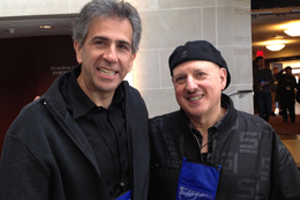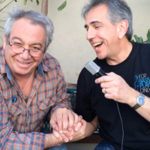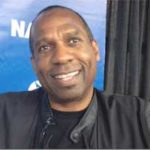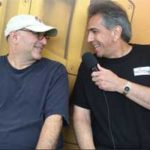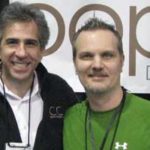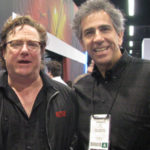Veteran jazz star and educator discusses bass influences, record dates and stepping out as a leader
Exclusive interview with FBPO’s Jon Liebman
August 10, 2009
Legendary bass master Harvie S has performed and recorded with many jazz luminaries, including Stan Getz, Chet Baker, Dexter Gordon, Jim Hall, Michael Brecker, Gil Evans, Mike Stern, Arturo O’Farrill, Lee Konitz, James Moody, Houston Person, Pat Metheny, Art Farmer, Toots Thielemans, Tommy Flanagan, Roland Hanna, Dr. Billy Taylor, Joe Lovano, John Scofield, Chick Corea, Erik Friedlander, Yusef Lateef, Danilo Perez, Paquito D’Rivera, Grover Washington Jr. and Pat Martino.
Harvie’s bass work can be heard on hundreds of CDs, both as a sideman and a leader. His long-standing duo with vocalist Sheila Jordan set the standard for bass and voice performance. Harvie has released some thirty CDs as a leader or co-leader, including Underneath It All, Urban Earth, Smart Moves, In a Different Light, Full Moon Dancer and Now Was the Time. Harvie’s bands have performed at major jazz festivals throughout the world, including JVC, Pori and many others. He is also the recipient of major grants from the National Endowment of the Arts, New York State Council on the Arts, ASCAP and many others. Harvie is a professor of jazz bass at Manhattan School of Music undergraduate and graduate divisions.
FBPO: Let’s start with your name. What’s up?
HS: My previous name was consistently misspelled and mispronounced. Resultantly, many performing opportunities were lost. I was hit hard financially and my career was affected. Since I changed my name in 2001, a lot of those issues have gone away, but for some reason more people now spell my name with an “ey” and a period after the “S” and I am trying to stop the problem before it get out of hand. It is just seven letters: Harvie S. Nothing more and nothing less.
FBPO: Talk about your upbringing and how you became a musician.
HS: I come from a completely non-musical family, but I always loved music. It has been my oasis and it fulfills me as much now as ever. As soon as I could walk, I went to the piano and started playing. When I heard jazz at age 15, I knew I had found my calling. I love to play many kinds of music. My musical tastes have ever expanded over the years.
FBPO: I remember having a conversation with you many years ago where you mentioned that you were self-taught. How did you figure out an instrument as beastly as an upright bass without any formal training?
HS: I enrolled and graduated as a composition major with a piano minor from Berklee College of music, but in my first year I realized that piano was not the instrument through which I could fully express myself. I continued taking piano lessons, but mostly played bass in combos and on gigs at Berklee.
Hearing a recording of Scott La Faro playing bass with Bill Evans awakened my senses to what I wanted to do musically. I am basically self-taught, but I have studied the instrument thoroughly by observing the masters, transcribing, and taking a classical lesson here and there. I still study and practice on a regular basis. Expanding my knowledge gives me great joy, release and satisfaction. I can always improve and I constantly try to evolve.
FBPO: Which bass players influenced you the most when you were coming up?
HS: In addition to Scott La Faro, whose playing struck me like a bolt of lightning, I focused on Ron Carter, Jimmy Garrison, Charlie Haden, Gary Peacock, Ray Brown and Paul Chambers. Over the years I have gone back and filled in my knowledge gaps by studying the very early bassists from the 1920s and some of the others I had missed. These artists include Oscar Pettiford, Eddie Safranski, Milt Hinton, Slam Stewart, Israel Crosby, Charles Mingus, Jimmy Blanton and Red Mitchell. I am always exploring and I have studied Afro-Cuban bass very intensely. My understanding of jazz deepened through my studies of African, Afro-Cuban and Caribbean music.
FBPO: Judging from the people with whom you’ve performed and/or recorded – Stan Getz, Chet Baker, Dexter Gordon, Jim Hall, Michael Brecker, James Moody, Tommy Flanagan, Dr. Billy Taylor, Pat Martino and many others – I’d say you’re a hard-core jazzer. What’s in your music collection that might surprise people? (I don’t imagine we’d find any ABBA or Village People – would we?)
HS: I listen to all styles of jazz. I may listen to Bud Powell and soon after move to Kurt Rosenwinkle or Ornette Coleman in one sitting. I also listen to a lot of Cuban, salsa, Brazilian, African and World music. I still groove on Frank Sinatra, Jimi Hendrix, Dolly Parton, Frank Zappa, and Motown (mainly because of James Jamerson’s genius bass lines).
I also love classical music and recently I’ve been listening Scriabin, Ligetti, Prokofiev and Bach, as well as Ravel’s music from Marlboro.
FBPO: Just curious: Have you done much playing on an electric bass?
HS: Absolutely yes! I have done a ton of playing on bass guitar. In my early days, I played about half of my gigs on it. I recorded on electric bass with James Brown, Eric Kloss and Dave Matthews. I did quite a bit of film, Broadway and commercial studio work, as well. I still play bass guitar. In fact, I just did a gig a few weeks ago on my trusty Fender Precision. I was actually in one of the earliest Fusion bands Barry Miles and Silverlight. I love playing bass guitar, but now I mostly play acoustic bass and mostly jazz.
FBPO: In addition to the hundreds of recordings on which you were a sideman, you’re also an established leader in your own right. Talk to me about Sheila Jordan and some of the other projects you’ve done, either as a leader or co-leader.
HS: My first real co-leadership was the band I co-founded with Dave Friedman, Mike diPasqua and Dave Samuels, called Double Image. We recorded two CDs – one for Enja and one for ECM. After that I co-led the duo with Sheila Jordan, which was a great experience because I had the opportunity to be arranger, musical director, bassist and stage artist. We performed for 14 years, toured the world and had a very successful run.
During that time I also made three CDs as a leader for Gramma-vision with sidemen David Sanborn, Mike Stern, Bob Mintzer, Charlie Mariano, Victor Lewis, Mino Cinelu and Erik Friedlander. I then made two CDs for Mesa-Bluemoon. One was the cult “guitar” CD titled In a Different Light, which featured me with Mike Stern, John Scofield, Mick Goodrick, Leni Stern and Gene Bertoncini.
In the mid 90s, I stretched my musical path wider and started to play Afro-Cuban music and ended up studying in Cuba. When I came back to New York, I started writing in that style and the result was a series of four latin jazz CDs. The first, on Bembe Records, was Havana Manana. It was followed by an independent release, New Beginning, which featured Michael Brecker and Ray Vega as guests. Texas Rumba, the première release on Zoho records, was soon followed by my CD, Funky Cha. My most recent release was a duo I recorded with Kenny Barron, called Now Was the Time, on High-note Savant records.
I recently finished a CD down in Texas for Blue Bamboo music with band from Houston, with Chris Cortez on guitar and Woody Witt on tenor sax and soprano. I haven’t worked the title yet, as we are just finishing the mix. This project contains a lot of new music I have written and arranged. I keep my website updated with any new developments. I am also collaborating with a 6-string contra-bassist Juan Garcia Herreros. It’s a two-bass band doing original music. We performed in Europe last summer and had a great experience.
FBPO: You’ve done an awful lot of traveling in your career. What are some of your favorite places to visit and where do you find the audiences to be most appreciative of the music?
HS: I wish I could say there was one place, but I have found great audiences all over the world, as well as audiences that are not so great. I have been so fortunate to see so much of the world, but wherever you go people are basically the same. Some are receptive and some aren’t. So far no particular country wins the prize.
FBPO: I’d almost forgotten how much I enjoy that special “piano/bass duo” sound. Tell me about Now Was the Time and working with Kenny Barron.
HS: Now Was the Time was done a while back when Kenny and I were doing a lot of gigs together. We basically went in the studio and played. There wasn’t any agenda. Almost everything we did was one take, live to two-track: no fixing no mixing.
I will say this: Kenny Barron is, without a doubt, one of the greatest musicians I have ever had the pleasure of playing with. He is immersed in the music the whole time and always elevates the experience. I can’t praise him highly enough.
FBPO: What else is keeping you busy these days?
HS: I have been studying orchestration and big band writing. I have also been doing a lot of performing recently with James Weidman. We are developing a wonderful musical relationship.
I am still at the Manhattan School of Music, teaching bass and jazz combos (undergraduate and graduate). I will be going on tour this year and early next year to Japan, Turkey, Austria, Israel, the Midwest, Amsterdam and Texas. I have some sideman recording projects and some writing projects coming up, too. It is looking like a really productive year. Thankfully, I love what I do.
FBPO: What do you like to do that’s not necessarily musically oriented?
HS: I love to cook, play with my dog, watch movies, take walks, read books and spend time with my wife.
